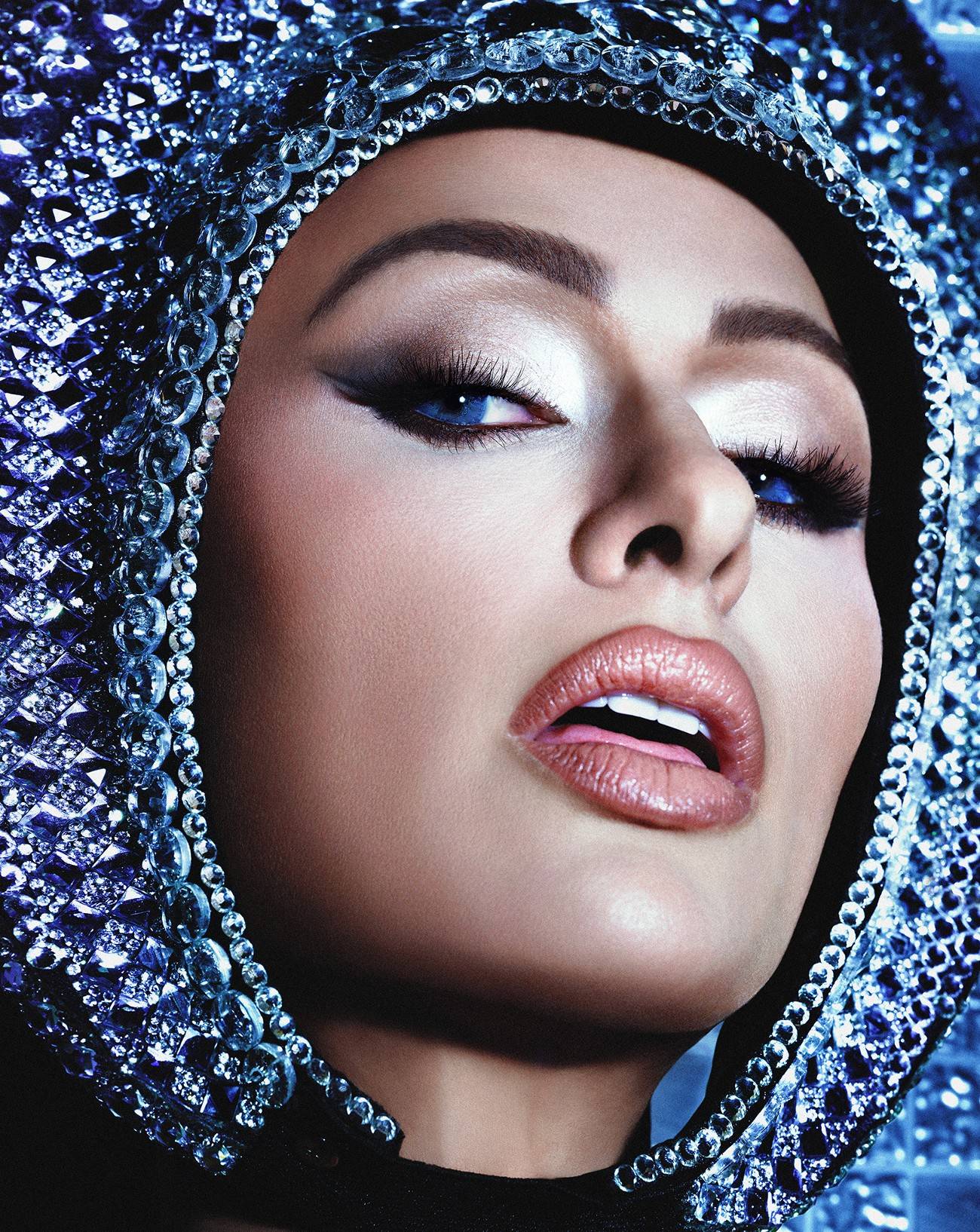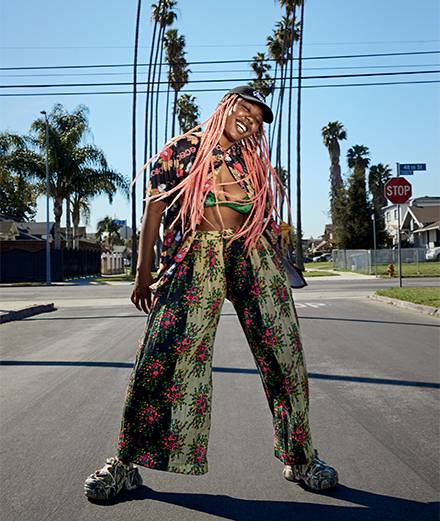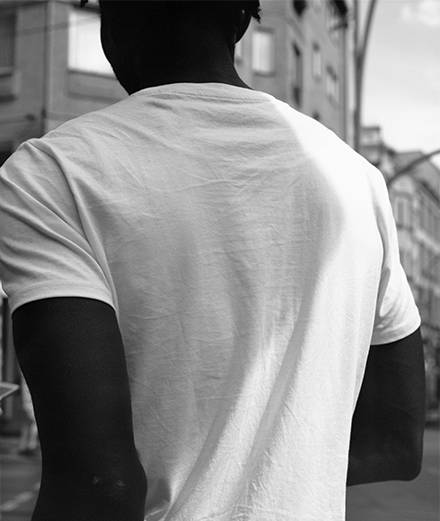© Nadia Lee Cohen. “Women” series (2018-2021).
Against a golden background, the title appears in red, bleeding letters: ‘Women’. The cover of this new book by photographer Nadia Lee Cohen, published in 2021 by IDEA, already sets the tone. Each and every one of its pages will talk about women, in a very specific manner : these dozens of photographs sharpen the vision of a strong and diverse femininity, far from being limited by beauty standards and univocal political ideas. Captured by day or by night in the naked streets of Los Angeles, in domestic interiors which bring us back to the glorious days of post-war America with their flowered wallpapers, vintage furniture and fitted carpets, in supermarket aisles, in churches or in local ballrooms, the models embody this diversity by revealing their unique fashion styles, but above all their naked bodies. Aside from the young and lanky silhouettes of some models such as Georgia May Jagger’s, we indeed discover older women with hanging breasts, chubbier waistlines and generous hips, sunbed tanned skins, excessive makeup styles and wigs, as well as corsets worn by drag-queens such as Violet Chachki. Six years ago, Nadia Lee Cohen started this ambitious series without yet grasping its purpose and grand finale. Still a student and already very fond of autoportraits, the young British woman simply started photographing the people who inspired her. The same way she herself poses in front of her camera, she anchors her models in a strong visual narrative, simultaneously recalling the great LA movie directors such as David Lynch, the photographs of Alex Frager, David LaChapelle and, of course, of queen of metamorphosis Cindy Sherman, and the hyperrealist sculptures of the American artist Duane Hanson. With their numerous expressions of nudity, their warm colors and their movie-like set-ups, these images deceive and thwart female archetypes in order to best redefine them : “The most important characteristic of these ‘Women’ is that they are not weak : they feel powerful, and in turn, make the other ones powerful.“, writes Nadia Lee Cohen in the book’s introduction. For Numéro, the photographer tells us about her project and numerous inspirations.
Numéro : You started the Women series six years ago. What was the starting point of this project?
Nadia Lee Cohen : The project unintentionally began at university as a smaller photo series that I naively believed I might complete in a year, however, it actually ended up taking six. I love photo books and feel that it's usually the truest representation of a person's work. It’s an opportunity for an artist to be indulgent in displaying what inspires you without having to answer to anyone. I wanted to create something that had that same authenticity and longer lifespan in a world that feels quite disposable and transient. I was working a lot commercially, which of course has its creative restrictions, so the book was like an escape in between those projects and provided me with an opportunity to carry out my more anarchistic ideas. Put simply, the book is a collection of staged fictional narratives featuring people I admire in one way or another.
There are 100 photographs and as many women in the book, even more, among which we find models, singer and performer Brooke Candy and drag-queen Violet Chachki... How did you choose the people you photographed?
Some are very close friends, others are people I have only met once with the intention of photographing them for the book. Together they are all individuals that I admire or am inspired by, and can portray a character interestingly.


With the exception of a few pictures, most of the models are photographed alone and often partially – even totally – nude. Why did you want to showcase their characters and their bodies in such frontal ways?
Really it was to celebrate the body. Now we are exposed to so much censorship and rules, I find any rebellion against this notion refreshing. I also believe it is important for us to be exposed to varying forms of the body in order to feel connected to our own. The degrees of nudity are determined by whatever the individual personally believes it is to feel ‘unclothed’, and this naturally differs from person to person.
Self-portraiture has played a big part in your photographic practice. However, only one portrait of yourself is included in this book among these dozens of characters, and we are barely recognizing you in it. How different is it for you to photograph yourself and photograph other people?
It’s not too different: I try to look at myself as an objective character, though this can be difficult as I have to separate myself from what I recognize in the mirror everyday in order to see myself more as a blank canvas. The character is of course formed as a part of my own observations and inspirations, so these characteristics naturally come through whether they are played by me or someone else.
“It is important for us to be exposed to varying forms of the body in order to feel connected to our own.”
Los Angeles is the big theater of this whole series. As someone who was born in the UK, and moved there to pursue your artistic career, do you remember your first impressions of the city when you visited it the first time? Why did you want to give it such an important role in this series?
My first impressions were mixed feelings of both exhilaration and repulsion. It felt like being dropped inside a movie set, as the signage, architecture and light were so familiar from movies I had watched, but there was a great deal of notable decay that I wasn’t expecting. Hollywood Boulevard is perhaps the best example of this, in terms of what one might expect to see but actually sees when visiting for the first time. However, overall those are the contrasting themes that inspire me the most and find their way into most of the imagery I make, which is probably why Los Angeles was featured so heavily in the book.


Los Angeles is also the crossing point of many art forms, cinema being one of the most important ones. How do you think this very creative context influenced your practice?
Being exposed to that kind of environment helped tremendously. I began working more as a director, and although this slowed down the process of making still images it really did benefit the creation of the imagery. Overall there was a noticeable improvement in terms of preconceived narrative, set design, lighting and general character creation. The concepts were more thoughtfully conceived like film stills rather than still images.
“Moving to Los Angeles, felt like being dropped inside a movie set.”
You described these photographs as parts of a “non-existent movie”. What movies and filmmakers do you consider essential to the building of you life, career and your own artistic vision?
I usually mention the directors but for a change I will list some of the movies I love. Films such as Vivre Sa Vie, True Romance, Gummo, The Birds, 8 1⁄2, The Shining, Goodfellas, Pulp Fiction, Weekend, Night on Earth, Paris, Texas, Apocalypse Now all inspired my initial image-making and helped me to understand the importance of narrative in combination with strong imagery.
As it is highlighted by the opening texts in your book, this work provides a very necessary female gaze on multiple forms of femininity. From your photography studies at the London College of Fashion and then your artistic career, have you experienced and maybe suffered from that prevalence of the male gaze as a female photographer?
I personally don’t feel that I have really encountered that much pushback from the art community as a female. However, I do feel it is still quite male dominated, especially in terms of directing, and we are ready for a shift here. The internet has allowed individuals to reach out to a wider audience and may be considered to have levelled the playing field enormously. Hopefully increased opportunities for self promotion will continue to produce a new generation of prominent female photographers and directors with the confidence to challenge the status quo. In considering the impact that photography exerts on society, viewed through a female lens, images may present the female form as considerably less idealised, thus objectified.
Women by Nadia Lee Cohen (2021), IDEA. The original edition is sold out but a special edition including a photographic print of Georgia May Jagger is still available on IDEA's website.
































